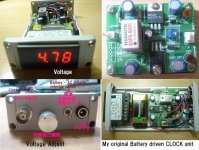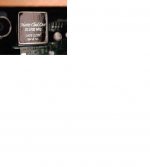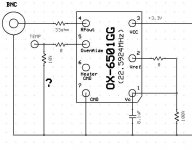Re: Re: Re: MAX2620 is better?/Cheap chip
Yeah forget it! Cheap chip!


Terry Demol said:
Don't get too excited, the Offset frequency on that grapph, is KHz
not Hz away from carrier.
So we are talking -105dBc/Hz at 10KHz not 10Hz.
This is to be expected it is a cheap chip solution.
cheers
T
Yeah forget it! Cheap chip!


Battery drive clock unit
Hi! Clock reserchers!
I made some clock unit, this is battery/AC power selectable unit.
How do you think this idea?
Joke? or Serious?
So,I held "clock audition" No.723 IKEON DCD-SA1 special audition.
http://www.ikeon.co.jp/impression/audio214.htm <---sorry Japanese
People like battery driven unit.
Hi! Clock reserchers!
I made some clock unit, this is battery/AC power selectable unit.
How do you think this idea?
Joke? or Serious?
So,I held "clock audition" No.723 IKEON DCD-SA1 special audition.
http://www.ikeon.co.jp/impression/audio214.htm <---sorry Japanese
People like battery driven unit.
Attachments
terra firma lite
I am running the Terra firma lite and its going well, no audible jitter in the way. I have run it with its own DAC (Oppo DV980 H uses a 192/24 DAC) and it sounds really good. I 'slave' an external DAC (2x2 BurrBrown PCM 1702) and it too benefits from the incredibly low jitter and sounds great! No issues with the Tent clock. The Vacuum State/JLTi guys are really onto something. Cant wait to go toe-to-toe with the Esoteric clocks
I am running the Terra firma lite and its going well, no audible jitter in the way. I have run it with its own DAC (Oppo DV980 H uses a 192/24 DAC) and it sounds really good. I 'slave' an external DAC (2x2 BurrBrown PCM 1702) and it too benefits from the incredibly low jitter and sounds great! No issues with the Tent clock. The Vacuum State/JLTi guys are really onto something. Cant wait to go toe-to-toe with the Esoteric clocks
Re: Neutron star
The fact that they uses a LM329 as a reference to qualify it as low noise design shows that they do not understand low noise design well.
It does not mean it will not be a good oscillator, but does erode my confidence.
Having said that, to buy really low noise cutting edge technology costs a bit more money.
udovdh said:
The fact that they uses a LM329 as a reference to qualify it as low noise design shows that they do not understand low noise design well.
It does not mean it will not be a good oscillator, but does erode my confidence.
Having said that, to buy really low noise cutting edge technology costs a bit more money.
Re: Re: Neutron star
To add further a phase noise vs frequency graph is the most meanigful way to specify the phase noise performance of an oscillator. As per nagaesan posts show.
If one is not supplied it further reduces confidence in the important performance parameter being claimed.
To add further a phase noise vs frequency graph is the most meanigful way to specify the phase noise performance of an oscillator. As per nagaesan posts show.
If one is not supplied it further reduces confidence in the important performance parameter being claimed.
How do you think this OCXO for Audio? Some one sais this is +/-0.5ppm deviation.
I think so, but recently a famouse maker adopted this +/-0.5ppm OCXO for their SACD player.
I don't understand why this diviation is +/-0.5ppm?
Please tell me if someone know what is "+/-0.5ppm"
EPSON/TOYOCOM OCXO(Oven Controlled Crystal Ascillator)
OX-6501GG
http://ndap3-net.ebz.epson.co.jp/w/...06f002d9d79/ab225a188f4a26264925750400074959/$FILE/OX-6501GG_E08X.pdf
Extreme_Boky said:
parts per million deviation is not that important;
Boky
I think so, but recently a famouse maker adopted this +/-0.5ppm OCXO for their SACD player.
I don't understand why this diviation is +/-0.5ppm?
Please tell me if someone know what is "+/-0.5ppm"
EPSON/TOYOCOM OCXO(Oven Controlled Crystal Ascillator)
OX-6501GG
http://ndap3-net.ebz.epson.co.jp/w/...06f002d9d79/ab225a188f4a26264925750400074959/$FILE/OX-6501GG_E08X.pdf
Attachments
Re: How do you think this OCXO for Audio? Some one sais this is +/-0.5ppm deviation.
And if someone know how to use "Heater GND" of OCXO, please teach me the problems when RF out GND connect Heater GND.
nagaesan said:
Please tell me if someone know what is "+/-0.5ppm"
EPSON/TOYOCOM OCXO(Oven Controlled Crystal Ascillator)
OX-6501GG
And if someone know how to use "Heater GND" of OCXO, please teach me the problems when RF out GND connect Heater GND.
Attachments
Nagesan,
>>And if someone know how to use "Heater GND" of OCXO, please teach me the problems when RF out GND connect Heater GND.<<
The schematic you posted looks like just one small part of a full data sheet or application note. Where did you get it, maybe the full data sheet is also there.
The schematic you posted does not make much sense, as I suspect the oven heater will not be connected if there is no earth connection for it.
I suspect the full datasheet will give much more information, that's what we need to find.
Regards, Allen (Vacuum State)
>>And if someone know how to use "Heater GND" of OCXO, please teach me the problems when RF out GND connect Heater GND.<<
The schematic you posted looks like just one small part of a full data sheet or application note. Where did you get it, maybe the full data sheet is also there.
The schematic you posted does not make much sense, as I suspect the oven heater will not be connected if there is no earth connection for it.
I suspect the full datasheet will give much more information, that's what we need to find.
Regards, Allen (Vacuum State)
Nagaesan,
You ask:
>>I don't understand why this diviation is +/-0.5ppm?
>>Please tell me if someone know what is "+/-0.5ppm"
This is the frequency SHIFT in percentage that can be adjusted by the user by changing the voltage on the control pin, Pin 2 "Vc".
This of course is really NOT wanted for a clock in audio equipment as any noise on that voltage on Pin 2 will be DIRECTLY turned into an FM modulation, which is JITTER!
Nagaesan,
do you have equipment that allows you to make jitter measurements on oscillators?
Regards, Allen (Vacuum State)
You ask:
>>I don't understand why this diviation is +/-0.5ppm?
>>Please tell me if someone know what is "+/-0.5ppm"
This is the frequency SHIFT in percentage that can be adjusted by the user by changing the voltage on the control pin, Pin 2 "Vc".
This of course is really NOT wanted for a clock in audio equipment as any noise on that voltage on Pin 2 will be DIRECTLY turned into an FM modulation, which is JITTER!
Nagaesan,
do you have equipment that allows you to make jitter measurements on oscillators?
Regards, Allen (Vacuum State)
The schematic was not datasheet but SACD player
Hello
That application was new high price SACD player's OCXO oscillator.
I don't really understand why they use OCXO with SACD player.
And also this SACD manufacture said this XO6501GG is +/-0.5ppm.
Allen Wright said:
The schematic you posted looks like just one small part of a full data sheet or application note.
Where did you get it, maybe the full data sheet is also there.
Hello
That application was new high price SACD player's OCXO oscillator.
I don't really understand why they use OCXO with SACD player.
And also this SACD manufacture said this XO6501GG is +/-0.5ppm.
In case of SACD player, the phase noise is important.
Because if clock purelity was worst there are spurious related playback music energy on phase noise, D/A converted analog signal have I/M distortion.
The frequency diviation is not important for audio equipment.
Because if D/A conversion fs frequency shift about +/- 1000ppm, D/A converted analog signal was fast or slow, but human ear cannot notice.
About 1998 to 2000, exchange clock ocillator and adding clock power unit in CD player, it was prevalent in Japanise enthusiast.
They choiced +/-1ppm TCXO that MTX0510 MITA DENPA.
And in Denmark, LcAudio made XO series clock unit for Audio.
Andin 2004, DENON release DCD-SA1 with "DENON called" +/-1ppm SPXO oscillator MXO183S MITA DENPA.
MXO183S is +/-10ppm SPXO MITA DENPA said their datasheet.
http://www.mitadenpa.co.jp/spxolist.htm#mxo1
I checked DCD-SA1 oscillation frequency with SR625 STANFORD RESERCH SYSTEMS. Frequency deviation was +27ppm.
I found this fraud, I say an objection to DENON president with inside report .
I checked MTX0510, MXO183S and XO3 phase noise with hp E5501B.
Because if clock purelity was worst there are spurious related playback music energy on phase noise, D/A converted analog signal have I/M distortion.
The frequency diviation is not important for audio equipment.
Because if D/A conversion fs frequency shift about +/- 1000ppm, D/A converted analog signal was fast or slow, but human ear cannot notice.
About 1998 to 2000, exchange clock ocillator and adding clock power unit in CD player, it was prevalent in Japanise enthusiast.
They choiced +/-1ppm TCXO that MTX0510 MITA DENPA.
And in Denmark, LcAudio made XO series clock unit for Audio.
Andin 2004, DENON release DCD-SA1 with "DENON called" +/-1ppm SPXO oscillator MXO183S MITA DENPA.
MXO183S is +/-10ppm SPXO MITA DENPA said their datasheet.
http://www.mitadenpa.co.jp/spxolist.htm#mxo1
I checked DCD-SA1 oscillation frequency with SR625 STANFORD RESERCH SYSTEMS. Frequency deviation was +27ppm.
I found this fraud, I say an objection to DENON president with inside report .
I checked MTX0510, MXO183S and XO3 phase noise with hp E5501B.
bleachershane said:After a bit of reading a while I figured that out, I think there's some confusion where people think PPM is something to do with the oscillators accuracy...
Isn't it more to do with it's drift tolerances in relation to temperature... I think I'm probably wrong!
When you order a clock, you specify a frequency. The PPM is how much the clock may deviate, as furnished new, from the perfect frequency over some specified set of conditions, like temperature.
Note that as crystals age over time, the frequency will usually drift. It's not uncommon to see a noticeable drift in say 3-5 (or more) years of maybe 25-50 ppm or more. In many cases a small cap is used in the oscillator circuit to adjust for this initial error and drift over time.
It's also important to know that many high end 2 stage PLL's as used in high end DACS only will adjust over a fairly limited range, say +/- 100PPM. This is because they are built around VCXO's with that limited +/- PPM "pull" range.
If the clock in the transport is off by more than say 100PPM from the reference frequency, the 2 stage input receiver based DAC won't lock to it. So in that sense it may be important, but as others mentioned, it has nothing to do with jitter.
>> PPM is something to do with the oscillators accuracy...<<
It is an accuracy spec, it's ERROR of frequency of the oscillation, in parts per million. Vital for frequency counters and GPS satellites, not real important in a CD player, because even a lowish quality crystal will be more accurate than needed.
>Isn't it more to do with it's drift tolerances in relation to temperature...<
PPM per se means very little, PPM per degree C is useful to know. oscillators in realtime clocks, frequency counters etc are specc'd in PPM per year, and some can be quite amazing. Drifting maybe a fraction of a second in a year!
But it's jitter that counts in a CD/SACD/digital audio player player, and that's a completely different ball game.
Regards, Allen (Vacuum State)
It is an accuracy spec, it's ERROR of frequency of the oscillation, in parts per million. Vital for frequency counters and GPS satellites, not real important in a CD player, because even a lowish quality crystal will be more accurate than needed.
>Isn't it more to do with it's drift tolerances in relation to temperature...<
PPM per se means very little, PPM per degree C is useful to know. oscillators in realtime clocks, frequency counters etc are specc'd in PPM per year, and some can be quite amazing. Drifting maybe a fraction of a second in a year!
But it's jitter that counts in a CD/SACD/digital audio player player, and that's a completely different ball game.
Regards, Allen (Vacuum State)
BFNY said:
So in that sense it may be important, but as others mentioned, it has nothing to do with jitter.
Well stated, and the redbook spec covers a max deviation of +/- 100ppm
best
Thank you BFNY, Allen and Guido for clearing that up, we all have to start somewhere I guess and I'm a relative newcomer to all this!
I think I made a mistake when I said "I think there's some confusion where people think PPM is something to do with the oscillators accuracy...", what I meant was it's accuracy in relation to jitter, which of course PPM has nothing to do with...
I thought there was some temperature relation specs in there in relation to PPM, thanks for that Allen...
After what BFNY said, is there any major benefits to clocking the transport from the one master clock through a divider circuit rather than the usual two separate clocks? This way the possibility of separate clock drift could not cause any locking problems?
I think I made a mistake when I said "I think there's some confusion where people think PPM is something to do with the oscillators accuracy...", what I meant was it's accuracy in relation to jitter, which of course PPM has nothing to do with...
I thought there was some temperature relation specs in there in relation to PPM, thanks for that Allen...
After what BFNY said, is there any major benefits to clocking the transport from the one master clock through a divider circuit rather than the usual two separate clocks? This way the possibility of separate clock drift could not cause any locking problems?
- Status
- This old topic is closed. If you want to reopen this topic, contact a moderator using the "Report Post" button.
- Home
- Source & Line
- Digital Line Level
- 16.9344MHz LOW JITTER CLOCK KIT...


